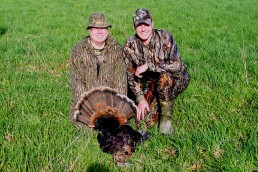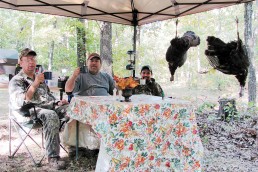Hunting Small Tracts of Land for Gobblers
SHARE THIS POST
In Mecosta County, Michigan where my family owns approximately 80 acres, decent numbers of turkeys inhabit the surrounding area. However, even though we have several small clover plots, numerous water sources and an abundance of turkey habitat, it can be tough holding them on our property. Oftentimes, turkeys roost on neighboring properties and spend a very brief period of their day feeding, strutting and traveling through the area. I recall two different longbeards that I intercepted while they were traveling across our property from the roost to a neighbor’s cornfield. This required a more aggressive tactic.
I refer to these birds as transient turkeys. This not only occurs on this piece of property, but in other areas I’ve had permission to hunt in the past. This can also include large tracts of public land that occasionally limit you to hunt turkeys in small areas due to hunting pressure from other turkey hunters, along with other outdoor enthusiasts.
As for private property throughout the state, land is continuing to become more fragmented and sold off as smaller parcels. Just look at some of the counties plat books and you will quickly see what I’m talking about. This trend will increase your chances of knocking on a landowner’s door who owns one of these small pieces of property. You can either pass up the chance to hunt on one of these small parcels or seize the opportunity and make the most of it.
That being said, here are some tips to help you fill your spring turkey tag when hunting small tracts of land for gobblers.
Scout and setup
When hunting small tracts of land, it is especially important to be aware of surrounding natural features that could present turkeys with an obstacle when responding to your calls. These include barbwire fences, creeks, thick brush and fallen trees. Scouting the area ahead of time for potential locations to set up will help alleviate this problem. It not only helps you avoid these obstacles, but also reveals areas where turkeys have been roosting and feeding.
Pinpointing these locations is essential when trying to put a gobbler on the ground. Put in some leg work well in advance of the season, searching the area for turkey sign such as tracks, dusting locations, droppings and feathers.
If you find large quantities of the latter two, the chances are you’ve just found a roost, which is the jackpot for setting up prior to opening day. Placing a trail camera(s) in areas where you’ve spotted turkey activity in the past also gives you an idea of where they’re spending time.
Driving on the roads around the area and glassing adjacent properties from afar is also a great way to determine their travel patterns and areas where gobblers like to strut. This avoids putting extra hunting pressure on the birds. While driving around, you may find out that the turkeys aren’t roosting on your property at all but have chosen to roost on the property next door. Gathering this information helps you determine where you will set up on your property and the direction you should face.
Tent blinds are excellent for remaining concealed in open areas such as fields and meadows where longbeards frequently spend their time strutting and feeding. A tent blind is just the ticket when hunting in smaller areas since you won’t be cutting and running nearly as often. On one piece of property near my home that consists of sixty acres where I have permission to hunt, I typically place two tent blinds in areas where turkeys are the most active. This helps increase my chances of filling my tag.
Are you enjoying this post?
You can be among the first to get the latest info on where to go, what to use and how to use it!
Half blinds are other options. These types of blinds are excellent when a gobbler is fast approaching and you are in the open and don’t have time to lean up against a tree or find other available cover. However, I oftentimes sit at the base of a tree when I’m cutting and running and hear a gobbler nearby.

Calling
If you discover that turkeys are roosting off the tract of land you are hunting, then it is best to call facing the opposite direction if you are hunting alone. However, if you have a hunting buddy who will be calling for you, then position yourself between them and the roost. This will give the longbeard the impression that the hen is moving in the opposite direction, therefore drawing him in close for a shot. You can also create this scenario by cutting and yelping loud at first, and then gradually becoming softer once the gobbler has committed to you. This tactic works best when you are calling alone.
Oftentimes, turkey hunters think that they need to be constantly calling to the birds to bring them in close to their setup; however, too much calling can have the opposite effect. This can cause the gobbler to feel that the hen, which is you calling, isn’t going anywhere anytime soon, so they’re thinking, “What’s the hurry?” By resisting the temptation to call too much, you can also cause gobblers to think that the hen is heading out of the area.
Used correctly and at the right time, turkey calls are among the tools to lure a gobbler from adjacent properties towards your setup. With a limited area to hunt, you need to make wise decisions in making your setup appealing to turkeys. Be patient and give birds enough time to react to your calls. This helps avoid pressuring the turkeys.
Stay positive
Like many turkey hunters, I’ve been limited to turkey hunting on smaller properties, whether it’s been on my family’s property or on the property of those who have generously given me permission to hunt. However, I don’t feel that this has negatively affected my success. It just makes the window of opportunity a little smaller than hunting on larger tracts of land where they have more room to roam and go about their daily turkey business. If anything, it has caused me to become a better turkey hunter, paying attention to detail on my approach, setup, calling, and knowing when to stay put versus cutting and running.
Absorbing information from all experiences—past turkey seasons, books, videos, seminars and talking to other experienced hunters who have spent countless hours in the turkey woods—have all contributed to my success, and it wouldn’t be possible without them. Stay positive when hunting these areas, because sooner or later, a longbeard will pass by, offering you a shot. After all, gobblers travel several miles a day, so your chances of hearing or seeing one on the property you’re hunting are good. Don’t think for a second that the “grass is greener on the other side,” but instead be confident in your setup and your turkey hunting skills.
MWO
SHARE THIS POST
Did you enjoy this post?
You can be among the first to get the latest info on where to go, what to use and how to use it!
Darin Potter
Darin Potter’s passion for outdoor writing began at the age of 12 when he first began writing in a journal that his parents bought him on a family camping trip in Northern Michigan. His writings have appeared in several Midwest publications: Michigan-Out-of-Doors, Michigan and Ohio Outdoor News, Modern Pioneer, and MidWest Outdoors.



